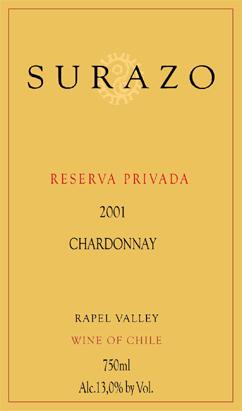2001 Rapel Valley Chardonnay
The Surazo Reserva Privada is a captivating Chardonnay from the renowned Rapel Valley, celebrated for its expressive terroir that imparts unique character to the wines produced here. This vintage from 2001 showcases a lovely golden hue, inviting you to explore its complexity. On the nose, it reveals an enticing bouquet of ripe stone fruit, complemented by subtle notes of oak and a hint of vanilla, a result of careful aging. The palate is wonderfully balanced, exhibiting a medium-bodied structure with refreshing acidity that uplifts the fruit flavors. Its dryness enhances the overall elegance, making this Chardonnay a delightful choice for a variety of culinary pairings. With its well-integrated oak and persistent finish, the Surazo Reserva Privada stands out as a testament to the artistry of winemaking in the Rapel Valley.
The Surazo Reserva Privada is a captivating Chardonnay from the renowned Rapel Valley, celebrated for its expressive terroir that imparts unique character to the wines produced here. This vintage from 2001 showcases a lovely golden hue, inviting you to explore its complexity. On the nose, it reveals an enticing bouquet of ripe stone fruit, complemented by subtle notes of oak and a hint of vanilla, a result of careful aging. The palate is wonderfully balanced, exhibiting a medium-bodied structure with refreshing acidity that uplifts the fruit flavors. Its dryness enhances the overall elegance, making this Chardonnay a delightful choice for a variety of culinary pairings. With its well-integrated oak and persistent finish, the Surazo Reserva Privada stands out as a testament to the artistry of winemaking in the Rapel Valley.




